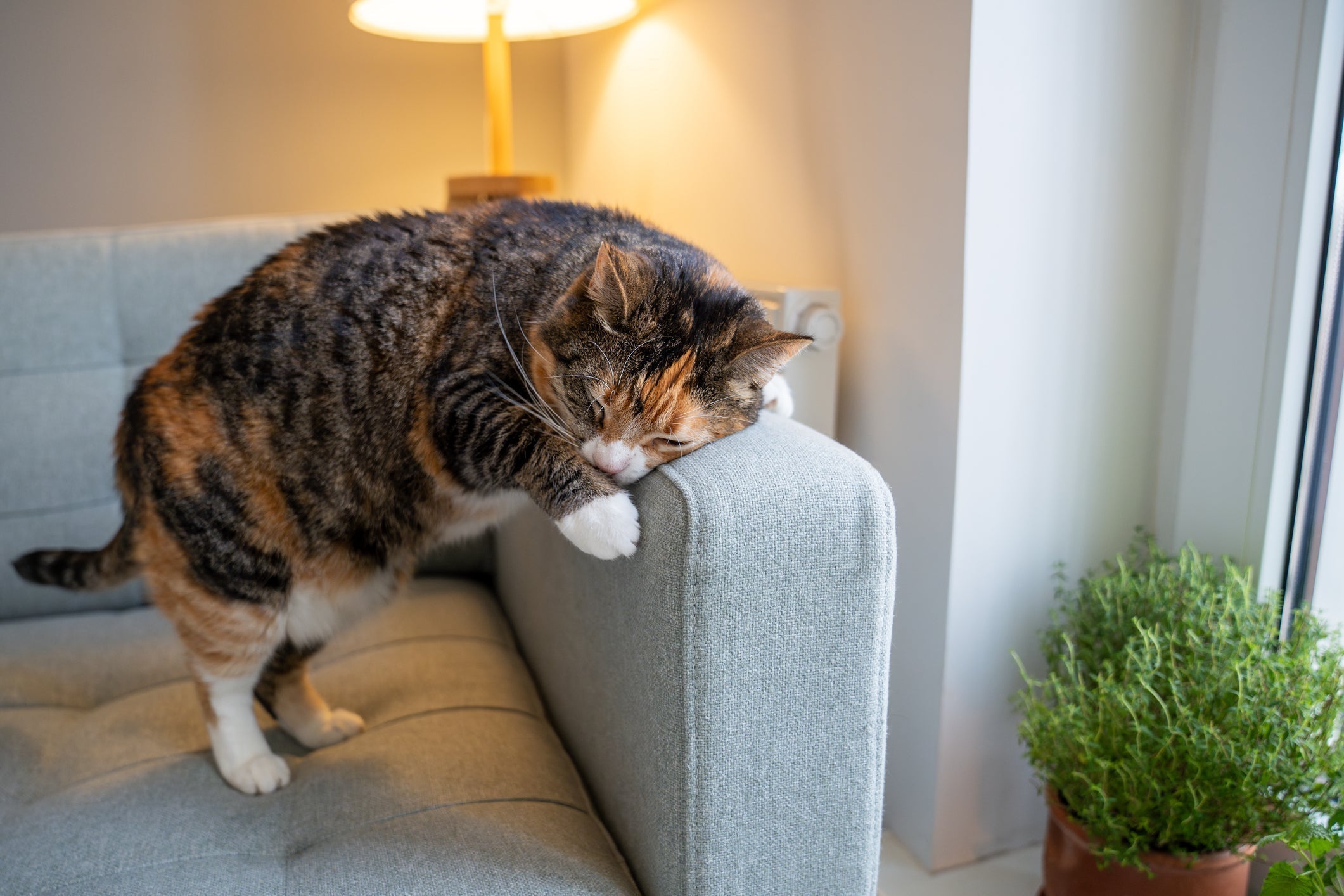How to Keep Cats From Scratching Furniture

Notice your once-pristine couch now looks like it's been through a feline makeover? You’re definitely not alone. Scratching is one of those classic cat behaviors that can push even the most patient cat parent to the brink. But before you start Googling for couch repair hacks, let’s take a closer look at why cats scratch furniture and how you can help them scratch smarter, not harder.
Key Takeaways
-
Scratching is a normal, healthy behavior. Cats scratch to care for their claws, stretch their muscles, mark territory, and release stress.
-
A calm home, a clean and inviting litter setup (like with Boxie Glo™), and consistent training can help reduce stress-based scratching.
-
Provide better alternatives (see below!) so your cat doesn’t scratch your furniture
Why Cats Scratch Furniture
Scratching Is Normal and Necessary
Cats aren’t scratching your furniture out of spite. They’re simply following their instincts. Just like dogs dig, cats scratch to keep their claws sharp, stretch their muscles, mark their territory with scent, and release stress or excitement. It’s less about destruction and more about doing what comes naturally.
Common Reasons They Target Furniture
Cats often scratch furniture because it offers the right texture, resistance, and stability, but there’s usually more going on. Without appealing alternatives like sturdy, well-placed scratching posts, furniture becomes the go-to option.
Boredom or a lack of stimulation can also lead to increased scratching as a way to burn off energy. In homes with more than one cat, it might even be a response to territorial stress. So when your cat targets the couch, it could be instinct, but it might also be their way of telling you that they need more outlets or enrichment.
How to Stop Cats From Scratching Furniture
Give Them Better Options
Vertical scratchers let cats stretch upward and work their back muscles, making them a great option for full-body exercise. These usually come as tall posts, cat trees, or wall-mounted designs. Horizontal scratchers sit flat on the floor and appeal to cats who prefer to scratch while lounging or leaning down. Offering both types gives your cat variety and can help redirect your cat from scratching your furniture.
In addition, cats are picky about what they scratch, and the material makes a big difference. Sisal, whether in rope or fabric form, is a favorite because it provides a satisfying texture and holds up well. Corrugated cardboard is another popular choice, and is easy to replace when it gets worn down. We recommend ones infused with catnip! Natural wood or bark-style surfaces are also great options as they offer a rough texture that many cats enjoy and can also look nice in your space.
Recommended Scratch Posts
1. Catit Scratcher with Catnip (Horizontal or Vertical)
Best for: Cats who scratch while lounging
-
Corrugated cardboard surface cats love
-
Comes with catnip to encourage use
-
Lightweight, affordable, and recyclable
-
Great for cats of all ages, especially seniors
Buy from: Chewy
2. PetFusion 3-Sided Vertical Cat Scratcher
Best for: Cats who like vertical, angled, and horizontal surfaces
-
Made from recycled corrugated cardboard
-
Safe, non-toxic glue and reversible for extended use
-
Doubles as a lounge spot for naps and play
-
Great for cats of all ages
-
Modern look fits well in stylish homes
Buy from: Chewy
3. Necoichi Cozy Cat Scratcher Bowl (Horizontal + Lounge Combo)
Best for: Cats who love to scratch, curl up, and snooze in one spot
-
Unique bowl shape satisfies your cat’s instinct to scratch, spin, and nest all in one cozy place
-
Made from sturdy, high-quality corrugated cardboard that's gentle on claws but tough on wear
-
Ideal for cats who enjoy horizontal scratching and compact lounging spaces
-
Stylish, minimalist design fits seamlessly into your home
-
Bonus: Many cats prefer this to their traditional beds
Buy from: Chewy
Smart Placement of Scratchers
Place scratchers in spots your cat already likes to scratch, such as near furniture or their favorite napping areas. Sprinkle some catnip or use toys to encourage exploration if they're not using them right away.
Make Furniture Less Appealing to Scratch
Use Safe Deterrents
To safely deter cats from scratching furniture, try using double-sided tape, aluminum foil, or plastic scratch guards. This makes surfaces less appealing without causing harm. Pet-safe sprays with scents like citrus or rosemary can also help, as cats tend to avoid those smells.
Covering furniture, trimming your cat’s nails regularly, and blocking access to problem spots can reduce damage. Most importantly, offer appealing alternatives like scratching posts nearby and reward your cat when they use them. This can help train your cat not to scratch your furniture. Avoid punishment, as it can lead to stress and behavioral issues.
Cover or Block Favorite Spots
If your cat keeps targeting the same spot, covering or blocking it can help break the habit. Slipcovers or furniture throws can protect the fabric and make the surface less satisfying to scratch. Clear scratch shields or furniture protectors create a smooth barrier that removes the texture cats love, without changing the look of your space too much. You can also use temporary barriers, like boxes or strategically placed furniture, to limit access while you train your cat to use a scratching post instead. Redirection works best when the original target is no longer as tempting.
Keep Claws Trimmed
Keeping your cat’s claws trimmed is a simple way to reduce damage from scratching without stopping the behavior entirely. Regular trims help prevent claws from becoming too sharp or catching on furniture, fabric, or even your skin during play. It also makes scratching less destructive while still allowing your cat to stretch and mark their territory.
Aim to trim every couple of weeks, using cat-safe nail clippers and plenty of treats for a positive experience. If you’re unsure or your cat is squirmy, ask a vet or groomer for help!
Train and Reinforce the Right Behavior
Positive Reinforcement Works Best
When it comes to managing scratching behavior, positive reinforcement and consistency are key. Reward your cat with treats, praise, toys, or attention whenever they use a scratching post or other approved surface. This helps them associate the behavior with something good and encourages them to repeat it.
Avoid Negative Reinforcement
On the flip side, avoid negative reinforcement like yelling, clapping, or using squirt bottles. These tactics can scare or stress your cat without actually teaching them what you want them to do instead. Worse, it may damage your bond and make them anxious around you.
Be Consistent
Consistency is just as important as kindness. Redirect your cat every time they scratch inappropriately by gently moving them to a scratching post or placing it near the area they’re targeting. Over time, clear and repeated guidance helps them build new habits and learn where it’s okay to scratch.
When to Get Extra Help
Rule Out Stress or Anxiety
If your cat is suddenly scratching more than usual or targeting new areas, it’s worth considering stress or anxiety as a possible cause. Big changes like a new pet in the home, a recent move, or shifts in your daily routine can all throw your cat off balance. When cats feel unsettled, they often use scratching as a way to cope, mark territory, or regain a sense of control.
Creating a calm and predictable environment can make a big difference for your cat. A clean and inviting litter area, especially when Boxie Glo™ litter, helps reduce stress and supports healthy bathroom habits. The UV sparkles instinctively guides the cat to the litter box, adding to your cat’s comfort and sense of security.
Talk to a Vet or Behaviorist
If the scratching persists or is accompanied by other behavior changes, talk to your vet or a feline behaviorist. They can help rule out medical issues and guide you through solutions tailored to your cat’s needs.
FAQ
Why do cats scratch furniture even if they have posts?
Even if your cat has a scratching post, they might still go for the furniture if the post isn't in the right location, doesn’t have a texture they enjoy, or isn’t the right type. Cats often scratch furniture because it offers the perfect combination of texture, stability, and visibility. If the scratching post is tucked away or made from a material they don’t like, your couch might seem like a better option. If your cat is feeling bored, anxious, or under-stimulated, they may turn to scratching your furniture as a way to relieve stress, particularly if the furniture is in a high-traffic or familiar area.
How can I train my cat to stop scratching?
Start by giving your cat more appealing alternatives. Provide both vertical and horizontal scratchers made of materials they enjoy, like sisal or cardboard, and place them near areas your cat already targets. Use treats, catnip, or toys to encourage your cat to use the new surfaces, and reward them when they do. At the same time, make furniture less appealing by using double-sided tape, citrus-scented sprays, or plastic scratch guards. Cover or block favorite scratch spots temporarily to break the habit. Most importantly, stay consistent. Gently redirect your cat to the scratcher every time they go for furniture, and avoid punishment, which can lead to fear or stress.
What smell will keep cats from scratching furniture?
Cats naturally dislike certain scents like citrus, rosemary, and eucalyptus. Pet-safe deterrent sprays made with these fragrances can help discourage scratching when applied to furniture. Always make sure any spray you use is specifically labeled as safe for cats. While scent can be helpful, it works best when combined with attractive alternatives like scratchers nearby.
Can older cats be trained to stop scratching?
Yes, older cats can absolutely learn to scratch appropriate surfaces with a little patience and consistency. Even if the habit has been around for years, providing the right type of scratchers in the right places, using positive reinforcement, and making furniture less tempting can all help. Be sure to rule out any stress or health issues first, especially if the behavior is new. Older cats may also benefit from easier-to-reach horizontal scratchers and softer materials. If you’re having trouble, a vet or feline behaviorist can help tailor a plan for your cat’s age and needs.
- Tags: Fur Family Fun


